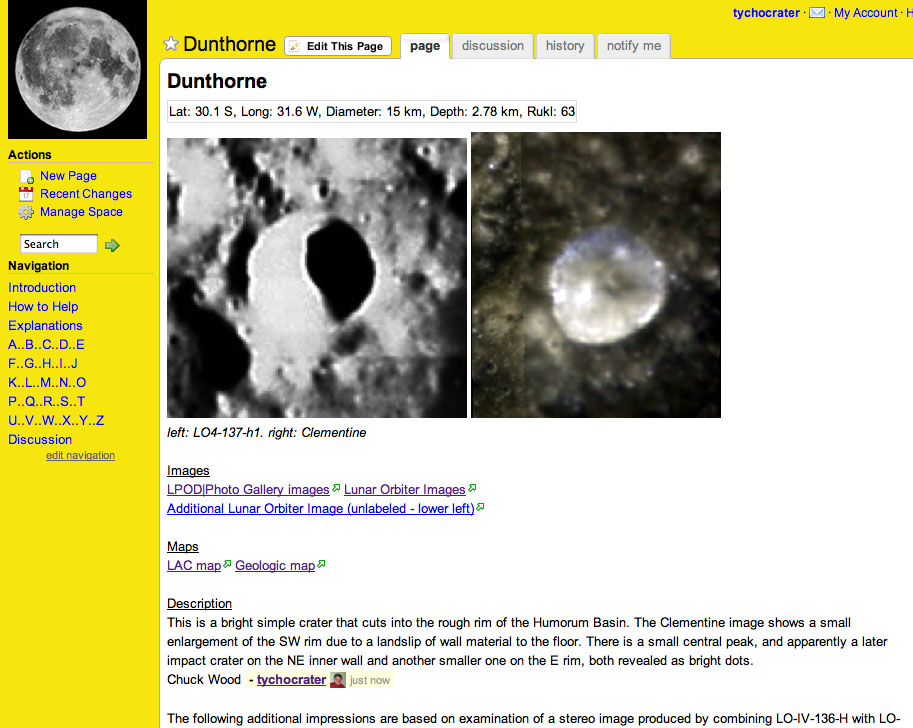|
|
| (5 intermediate revisions by the same user not shown) |
| Line 1: |
Line 1: |
| | __NOTOC__ | | __NOTOC__ |
| − | =Rapid Growth, More To Come= | + | =Rapid Growth, More to Come= |
| | + | <!-- Start of content --> |
| | <div class="post" id="post-1191"> | | <div class="post" id="post-1191"> |
| | | | |
| | <div class="storycontent"> | | <div class="storycontent"> |
| | <p>[[File:DunthorneWiki-LPOD.jpg|DunthorneWiki-LPOD.jpg]]<br /> | | <p>[[File:DunthorneWiki-LPOD.jpg|DunthorneWiki-LPOD.jpg]]<br /> |
| − | <em>image from [http://the-moon.wikispaces.com/ the-Moon] wiki </em></p> | + | <em>image from [https://the-moon.us/wiki/ the-Moon] wiki </em></p> |
| − | <p>The LPOD of two Mondays ago introduced a new online lunar resource: [http://the-moon.wikispaces.com/Introduction the-Moon] wiki. In the two weeks since there have been 1141 edits - essentially additions to the site. This top piece of a page about the minor crater Dunthorne is a great example of how a successful wiki works. Over the last seven days, three people made 20 edits to create and improve the entry. I added the inital entry for Dunthorne with a Lunar Orbiter image, and later Mark Tillotson (a person I had never met or even emailed) added data on the location and size of the crater and some biographical information about the British amateur astronomer it honors. I then added a Clementine image and based on that wrote a short geological description to compliment the 100 year old one from Elger. A day or so later, Jim Mosher, who I have met via online lunar forums, added accurate coordinates and depth and diameter data as summerized by Kurt Fisher and from his own measurements. Jim also made a stereo pair from Lunar Orbiter images and based on that wrote a detailed description of Dunthone’s topography. I would wager there is now more information about Dunthorne on this wiki than anywhere else in the world - and some of the information is new. As old information is recovered, and new discovered, <em>the-Moon</em> will be a convenient and easy place to archive it. All of this, plus information on 100-150 other lunar features (including oddities like Mare Pacificus) has been complied by three people over two weeks! Mark, especially, has become indefatigable in adding 429 edits so far! Imagine if there were five or 10 additional lunatics compiling crater dimensions, images, history, and descriptions. There is an immense amount of work to do, and each edit adds another reason to seek out <em>the-Moon</em> wiki as a growing encyclopedia of our favorite satellite. Come join us.</p> | + | <p>The LPOD of two Mondays ago introduced a new online lunar resource: [https://the-moon.us/wiki/Introduction the-Moon] wiki. In the two weeks since there have been 1141 edits - essentially additions to the site. This top piece of a page about the minor crater Dunthorne is a great example of how a successful wiki works. Over the last seven days, three people made 20 edits to create and improve the entry. I added the inital entry for Dunthorne with a Lunar Orbiter image, and later Mark Tillotson (a person I had never met or even emailed) added data on the location and size of the crater and some biographical information about the British amateur astronomer it honors. I then added a Clementine image and based on that wrote a short geological description to compliment the 100 year old one from Elger. A day or so later, Jim Mosher, who I have met via online lunar forums, added accurate coordinates and depth and diameter data as summerized by Kurt Fisher and from his own measurements. Jim also made a stereo pair from Lunar Orbiter images and based on that wrote a detailed description of Dunthone’s topography. I would wager there is now more information about Dunthorne on this wiki than anywhere else in the world - and some of the information is new. As old information is recovered, and new discovered, <em>the-Moon</em> will be a convenient and easy place to archive it. All of this, plus information on 100-150 other lunar features (including oddities like Mare Pacificus) has been complied by three people over two weeks! Mark, especially, has become indefatigable in adding 429 edits so far! Imagine if there were five or 10 additional lunatics compiling crater dimensions, images, history, and descriptions. There is an immense amount of work to do, and each edit adds another reason to seek out <em>the-Moon</em> wiki as a growing encyclopedia of our favorite satellite. Come join us.</p> |
| | <p>[mailto:tychocrater@yahoo.com Chuck Wood]</p> | | <p>[mailto:tychocrater@yahoo.com Chuck Wood]</p> |
| − | <p><em>You can support LPOD when you buy a lunar book or ANY book from Amazon thru [[LPOD]]</em></p> | + | <p><b>Yesterday's LPOD:</b> [[June 17, 2007|A Nomenclatural Screwup]] </p> |
| | + | <p><b>Tomorrow's LPOD:</b> [[June 19, 2007|When Goddesses Collide]] </p> |
| | + | <!-- Removed reference to store page 2 --> |
| | </div> | | </div> |
| − | ---- | + | <!-- End of content --> |
| − | ===COMMENTS?===
| + | {{wiki/ArticleFooter}} |
| − | Click on this icon [[image:PostIcon.jpg]] at the upper right to post a comment.
| |




